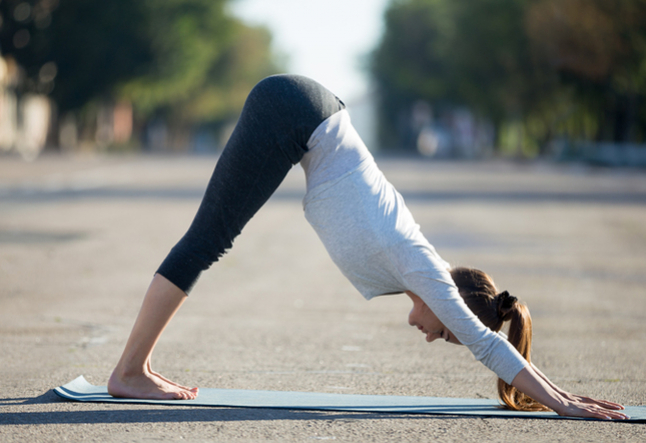extra tips for practicing basic postures safely

use your imagination to help you
“Spread weight, lift sitting bones up, firmly press palms into the mat.” These are some of the sentences you normally hear from your yoga teacher during class, but here is the answer for “How will I do this?”
Here are some tips for your practice of Dog poses (both of them, Upward and Downward Facing) and Full Forward Bend.
Downward Facing Dog (in Sanskrit Adho Mukha Svanasana)
1. IMAGINE you have an invisible sixth finger between your index finger and thumb and press it to your mat.
This will help you to press using the most difficult area of your palms and protect your wrists.
2. Slightly bend your knees, PUSH your sitting bones up towards the sky, then straighten your legs and lift you knee cups.
This movement will help you to understand where your sitting bones belong in this pose.
3. IMAGINE your weight traveling up from your fingers through your hands, back to your sitting bones and then drop it pound by pound (kilo by kilo) to your heels.
It’s all about spreading your weight between your hands and feet. Imagination is always helpful.
4. GIVE your neck a chance to breath in the pose, release your neck by moving your shoulders into their sockets.
An important part of this posture is to keep your head between your shoulders or lower, but always relaxed.
Upward Facing Dog (in Sanskrit Urdva Mukha Svanasana)
1. MOVE your elbows forward in the same direction as your eyes.
This movement will help your with the rotation of your upper arms.
2. PRESS through the tops of your feet.
In Upward Dog your knee caps automatically lift up in the correct position to protect your bones and knees.
3. LOOK UP and release your head backward.
Your chest will follow your gaze, creating more open space as this pose is basically a heart opener.
4. Always ENGAGE your abs in this pose (and other backbends too)
While you think you’re only engaging your belly, you are actually engaging
all your abdominal muscles and protecting your lower back from injury.
Full Forward Bend (in Sanskrit Uttanasana)
1. PLAY around spreading your weight between your heels and balls of your feet.
This play helps you to understand when your pelvis is right above your heels for correct posture.
2. MOVE your sitting bones up.
Using a wall is very useful for this one. The wall will help you to feel
that moment when your forward fold starts with the sitting bones instead of your lower back.
3. ENGAGE your quadriceps to lift your knee cups.
Do not push your knees backwards to “strengthen” the legs.
4. HUG your knees or place palms under your feet.
Such movements create extra bend and allow you to safely stay in your comfort zone for a better practice.